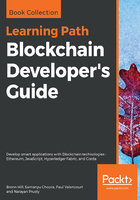
上QQ阅读APP看书,第一时间看更新
Bitcoin block
Here is a snapshot of a Bitcoin block:

Both Bitcoin and Ethereum are PoW chains; let's look now at a Proof of Stake (POS) ecosystem: Bitshares.
Here is some data from a Bitshares block:

Despite a radically different architecture, the fundamentals remain: references to a previous block, Merkle root, and network metadata. In Bitshares, you can also see that there is a Witness Signature. As a PoS blockchain, Bitshares has validators (they are called witnesses). Here, we see the witness and signature of the computer responsible for calculating this block.